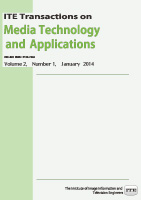Volume 2, Issue 2
Displaying 1-15 of 15 articles from this issue
- |<
- <
- 1
- >
- >|
Special Section on Advanced Image Sensor Technology
-
2014 Volume 2 Issue 2 Pages 94
Published: 2014
Released on J-STAGE: April 01, 2014
Download PDF (27K) -
2014 Volume 2 Issue 2 Pages 95-101
Published: 2014
Released on J-STAGE: April 01, 2014
Download PDF (1045K) -
2014 Volume 2 Issue 2 Pages 102-107
Published: 2014
Released on J-STAGE: April 01, 2014
Download PDF (873K) -
2014 Volume 2 Issue 2 Pages 108-113
Published: 2014
Released on J-STAGE: April 01, 2014
Download PDF (577K) -
2014 Volume 2 Issue 2 Pages 114-122
Published: 2014
Released on J-STAGE: April 01, 2014
Download PDF (561K) -
2014 Volume 2 Issue 2 Pages 123-130
Published: 2014
Released on J-STAGE: April 01, 2014
Download PDF (777K) -
2014 Volume 2 Issue 2 Pages 131-138
Published: 2014
Released on J-STAGE: April 01, 2014
Download PDF (844K) -
2014 Volume 2 Issue 2 Pages 139-144
Published: 2014
Released on J-STAGE: April 01, 2014
Download PDF (306K) -
2014 Volume 2 Issue 2 Pages 145-153
Published: 2014
Released on J-STAGE: April 01, 2014
Download PDF (1224K) -
2014 Volume 2 Issue 2 Pages 154-160
Published: 2014
Released on J-STAGE: April 01, 2014
Download PDF (991K) -
2014 Volume 2 Issue 2 Pages 161-166
Published: 2014
Released on J-STAGE: April 01, 2014
Download PDF (1773K) -
2014 Volume 2 Issue 2 Pages 167-175
Published: 2014
Released on J-STAGE: April 01, 2014
Download PDF (471K) -
[Paper] Object Tracking and Image Restoration from Multi-Frame Images Captured in a Dark Environment2014 Volume 2 Issue 2 Pages 176-184
Published: 2014
Released on J-STAGE: April 01, 2014
Download PDF (1587K)
Regular Section
-
2014 Volume 2 Issue 2 Pages 185-191
Published: 2014
Released on J-STAGE: April 01, 2014
Download PDF (301K) -
2014 Volume 2 Issue 2 Pages 192-198
Published: 2014
Released on J-STAGE: April 01, 2014
Download PDF (905K)
- |<
- <
- 1
- >
- >|
